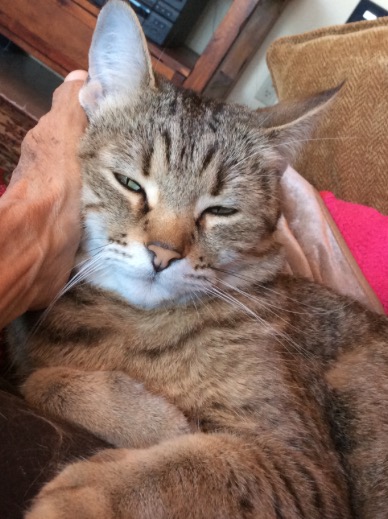Chantal Harte is a massage therapist living and working in Nosara, Costa Rica. She’s also a student of our upcoming professional cuddler certification program. When we met via Skype this week, I was impressed with her background dedicated to the healing arts. Later, we were sharing a simple email about something administrative. At the bottom of her note she included a P.S. that intrigued me.
“It struck me this morning that the ambivalent attachment style of the female cat [at our AirB&B] is part of my preparatory work for your training (and life)! One day, she scratched me badly for bypassing her cues about touch. The next day, she surprised me by crawling into my lap while I was studying on the couch.”
Chantal included a photo of the two of them in “blissland.”

Chantal’s experience with the cat had me thinking about body language and the difference between cats and humans. At Cuddle Sanctuary, there’s a guideline we explain at the beginning of our events called “Ask and Wait.” The idea is simple, if you want to touch someone, ask them. Then wait for their answer. If they say “Yes,” go ahead. If they say “No,” be gracious and accepting. Sounds simple, right?
But there’s more to it. We refine “Ask and Wait” with another concept called “Bit by Bit.” I’ll explain how “Bit by Bit” works with a dialogue of someone doing it well:
A: May I hold your hand?
B: Sure!
[They hold hands.]
A: May I give you hand massage?
B: That would be great.
In this example, Person B doesn’t assume that just because they are holding hands that Person A would consent to a hand massage. So Person A does a great job of asking for consent “bit by bit.”
We demonstrate this several times at Cuddle Sanctuary because we realize that for most people, it’s new and different. Sometimes, when I explain this guideline, a first timer will ask permission for a more familiar alternative.
“Can’t I just pay attention to body language?”
I can understand why a newcomer would ask that question. “Ask and Wait” can feel clunky and awkward. Wouldn’t it be nicer not to interrupt the flow? In a perfect world it would be nice to be able to count on nonverbal cues when it comes to touch. The reality is that body language – when it comes to humans – can be inaccurate.
Which brings me back to the cat.
Cats can’t talk. If you want to have a good touch experience with a cat, you have only her body language to guide you. (Chantal will tell you to pay close attention or you may get scratched!)
Here’s another thing, cat’s don’t lie. A cat won’t make her body language look like she’s enjoying something when she isn’t. Humans can lie with their body language and often do.
Why would anyone lie with their body language?
Maybe I shouldn’t use the word lie. When people misrepresent their body language, it isn’t to fool the other person. It’s often to serve purposes they value higher than being honest.
One purpose is to create social ease. For women in particular, the culture has taught us to get along and not make waves. It’s much easier socially to smile and accept a hug that’s not wanted – for the sake of social nicety.
Imagine two newcomers at a cuddle event. One of them is trying to use body language and without asking begins giving the other a shoulder massage. He’s trying to do a great job. The one receiving the massage has an injury to her left shoulder and it’s burning. She doesn’t want to hurt his feelings, and so she tolerates it.
Another reason that a person may display inaccurate body language is trauma. When a person has had a traumatic experience, he/she may feel unsafe in the future when in similar situations. This is called a trigger. When someone gets triggered, they may react with fight, flight or freeze. I bet you’ve heard of fight or flight. But have you heard of freeze? It’s quite possible that a person may be quiet and sitting still making you think they are relaxed. In reality that person may be quite freaked out – “frozen” due to trauma.
What? You mean I can never rely on body language?
Once, a dear friend spontaneously caressed my shoulder. My heart bloomed with a feeling of belonging. What made that moment possible was a lot of trust between us over time. We know each other well and have given each other permission for spontaneous touch. So…no! I’m not saying you can never be spontaneous with touch in your life.
I do believe that spontaneity and body language is possible with mutual trust and understanding between people. And that takes time. At Cuddle Sanctuary, we are most often a group of people who don’t all know each other. There are almost always newcomers. Therefore we use “Ask and Wait.”
Because we’re human beings, and not kitties.

